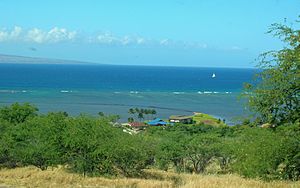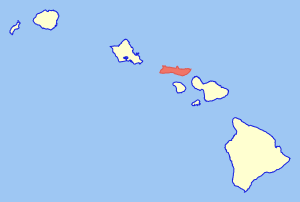Archeological Sites at Kawela facts for kids
Kawela is a special place on the southern coast of Molokaʻi island in Hawaii. It's known for its many old archeological sites, which are like clues from the past. Long ago, two important battles in Hawaiian history happened here.
Early History of Kawela
The name Ka Wela means "the heat" in the Hawaiian language. It was a traditional land area in ancient Hawaii. Kawela is about 4.5 miles (7.2 km) east of the town of Kaunakakai.
You can still see an ancient Hawaiian temple, called a heiau, on a ridge in Kawela. This heiau is believed to have been a "place of refuge" (Puʻuhonua). This was a safe place where people could go during wars or if they broke a sacred law.
Around 1737, a big battle took place here. Soldiers from Kapiʻioho o kalani found safety at this Puʻuhonua.
Later, in 1795, Kamehameha I was conquering the Hawaiian islands. Women and children from Maui escaped to Molokaʻi. Kamehameha's large fleet of war canoes followed them. His army faced little resistance this time.
Queen Kalola of Maui was asked to unite the kingdoms. Her daughter, Keōpūolani, was a very important royal. She married Kamehameha I. Their children and grandchildren would later rule the Kingdom of Hawaii.
In the late 1800s, Kawela was part of a huge ranch. This ranch was owned by King Kamehameha V.
Kawela Today

Today, Kawela has some vacation homes along the shore. There is also a neighborhood with 120 lots on the hills. These lots are set aside for farming. This development started in 1980.
Near the shore, you can find important wetlands and an old fishpond. These areas are protected in the Kakahaiʻa National Wildlife Refuge. They are also part of Kakahaiʻa park, managed by Maui County.
There are 21 important archeological sites in Kawela. These sites are listed on the National Register of Historic Places. This means they are recognized as very important historical places. These sites include old homes, farming areas, burial grounds, and religious structures. They help us learn about how people lived in ancient Hawaii. Most of these sites are on private land, so they are not open to the public.


